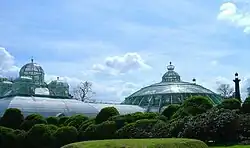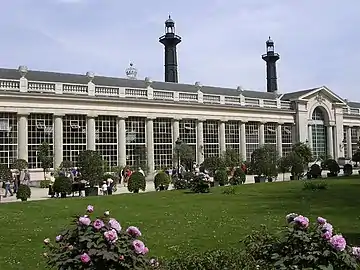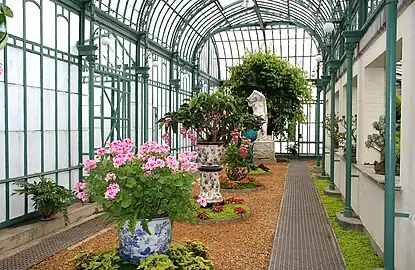Royal Greenhouses of Laeken
The Royal Greenhouses of Laeken (French: Serres Royales de Laeken, Dutch: Koninklijke Serres van Laken) are a vast complex of monumental heated greenhouses in the park of the Royal Palace of Laeken (northern part of the City of Brussels), Belgium. The historic complex contains tropical, subtropical and cold greenhouses.[1]
| Royal Greenhouses of Laeken | |
|---|---|
| Serres Royales de Laeken (French) Koninklijke Serres van Laken (Dutch) | |
 The Congo Greenhouse (left) and the Winter Garden (right), part of the Royal Greenhouses of Laeken | |
| Type | Greenhouses |
| Location | Laeken, City of Brussels, Brussels-Capital Region, Belgium |
| Coordinates | 50°53′18″N 4°21′37″E |
| Area | 2.5 ha (6.2 acres) |
| Created | 1874 |
| Owned by | Belgian State (donation of the Royal Heritage) |
| Public transit access | Stuyvenbergh |
| Website | Official website |
The greenhouses were designed and built by Alphonse Balat on behalf of King Leopold II.[2] They are now part of the Royal Domain and the royal private gardens belonging to the Belgian royal family, and are accessible to the public only a few days a year. This site is served by Stuyvenbergh metro station on line 6 of the Brussels Metro.
History
Inception and construction
The original gardens of the Royal Palace of Laeken date back to the 18th century, but King Leopold II drastically changed their appearance. The king, having visited the Crystal Palace at the Great Exhibition of 1851 in London, wanted such a progressive building in his palace's garden, which would combine his love for plants with multifunctional spaces that could also be used as a banquet, theatre and dining halls. He called on the botanist Jean Linden for this project, but his design was too unambitious. He then commissioned his architect Alphonse Balat. Balat's plans surpassed all that had been achieved at the time, even the Palm house in London's Kew Gardens (1844–1848) and Carl Bouché's botanical garden in Berlin-Schöneberg. The realisation came about in close consultation between Balat and the king, following frequent discussions, correspondence and preliminary designs.[2]

The first construction phase took place between 1874 and 1893, ending with the completion of the so-called Iron Church, a domed greenhouse, which would originally serve as the royal chapel. The inauguration took place in 1880, but the complex was also expanded afterwards. During that period, the king was preparing his Congo Free State, a private colony which was founded in 1885. The greenhouses were intended as a symbol of the king's colonial power: plants from Central Africa were said to illustrate that power. In particular, the Congo Greenhouse and the Embarcadère Greenhouse were built in 1886–1888 from this perspective. A third zone was constructed from 1892 to 1905. For this, after Balat's death, Leopold called upon the architects Henri Maquet and Charles Girault. The octagonal Palm Pavilion was furnished as a bedroom and connected to the palace by a subterranean corridor where Leopold received his mistresses. After the death of the king, in 1909, the greenhouses were preserved, but the Iron Church was converted into a private royal bathing house.
Present-day

The Winter Garden at the palace in Laeken still serves as the setting for royal receptions. Every year in the spring, the greenhouses are partially opened to the public for twenty days at the request of Leopold II. This tradition has been carried on by all monarchs who reigned after him.[2] The greenhouses are also sometimes used today for contemporary art exhibits and displays, such as Alexandre Dang's The Dancing Solar Forget-Me-Not for the International Day of Missing Children (in cooperation with Child Focus) in 2010.
Description
The Royal Greenhouses of Laeken are among the major monuments of the 19th century in Belgium. They were built entirely in metal and glass, which represented a spectacular innovation for the time (as was the Crystal Palace in London). This complex takes on the appearance of a glass city set in a hilly landscape. It is characterised by monumental pavilions, glass domes, as well as wide galleries that run through the land like covered streets.[2] The total floor surface of this immense complex is 2.5 ha (6.2 acres). Approximately 800,000 litres (210,000 US gallons) of fuel oil are needed each year to heat the buildings.
Winter Garden
The largest greenhouse, the round-domed Winter Garden (1874) with a diameter of 57 metres (187 ft) and a height of 25 metres (82 ft), is made up of a number of concentric cast iron trusses, which are additionally supported halfway through their span by a circular Doric colonnade. The start and end points of the trusses rest on the ground so that the greenhouse presents the image of a glass dome supported by flying buttresses. Its enormous dimensions made it possible to plant Congolese palm trees in the rotunda. This Winter Garden, the main building of the complex, was also of great importance for the development of cast-iron architecture.
Other greenhouses
Between 1885 and 1887, Balat designed the Palm Greenhouse, the Congo Greenhouse, the Diana Greenhouse, and the Embarcadère Greenhouse. The latter consists of two parallel compartments under a barrel vault, the second of which contains a dome supported by iron Corinthian columns. It is decorated with Chinese vases and two statues by the sculptor Charles Van der Stappen (The Dawn and The Evening). Finally, in 1893, the Iron Church was added, a neo-Byzantine ensemble surrounded by wreath chapels, the dome of which is supported by twenty columns of Scottish granite. This greenhouse is therefore also officially called the Chapel Greenhouse.
Royal Botanic Collection
Famous is the Royal Botanic Collection, with old plants from Africa and various species of flowers which are cultivated inside the royal greenhouses for use at court. Though the current collection has lost many cultivars since the death of Leopold II, the collection is still famous.[1] In 1909, there were 314 species of camellias in the royal collection, with more than 1000 plants. Today, only 305 remain. The camellias are the world's largest and oldest collection in a greenhouse. The orange tree collection of Leopold II was renowned with 130 trees aged 200 to 300 years, and one even 400 years old. In the 1970s, only 45 trees were still alive.[1]
Visit

The royal complex can only be visited each year during a two-week period in April–May, when most flowers are in full bloom. It is the opportunity to discover one of the most remarkable monuments of Belgian heritage and to admire the collections of exotic plants and flowers, some of which have been brought back from expeditions to the Congo for Leopold II.
Other times, the greenhouses are visited by heads of state during official visits. Famous visitors have included:
- Archduke Rudolf was engaged in the new Winter Garden (1880).
- Laura Bush, First Lady of the United States (2001)
- Melania Trump, First Lady of the United States (2017)
Gallery
Exterior

 View of the Orangery in the direction of the theatre
View of the Orangery in the direction of the theatre Winter Garden
Winter Garden Embarcadère Greenhouse and Congo Greenhouse
Embarcadère Greenhouse and Congo Greenhouse Greenhouse view
Greenhouse view
Interior
 Under the dome of the Winter Garden
Under the dome of the Winter Garden Junction between the Winter Garden and the Orangery
Junction between the Winter Garden and the Orangery Interior of the Embarcadère Greenhouse
Interior of the Embarcadère Greenhouse Interior of the Congo Greenhouse
Interior of the Congo Greenhouse The long glass gallery in bloom
The long glass gallery in bloom Interior of the Diana Greenhouse
Interior of the Diana Greenhouse Bust of Leopold II by Thomas Vinçotte
Bust of Leopold II by Thomas Vinçotte
References
Notes
- De tuinman & de koning: Het domein van Laken & zijn bewoners Boek van Erlend Hamerlijnck en Paul Van Gorp
- "Royal Greenhouses in Laeken". The Belgian Monarchy. Retrieved 31 December 2021.
Further reading
- Karin Borghouts, Irene Smets, Baudouin d'Hoore, Les Serres royales de Laeken (in French), BAI, 2019, 160 p. ISBN 978-90-8586-796-8
- Edgard Goedleven, Les Serres royales de Laeken (in French), Brussels, Duculot, Inbel, 1988
- Edgard Goedleven, Les Serres royales de Laeken (in French), Brussels, Racine & SFI, 1997
- Piet Lombaerde et Ronny Gobyn, Léopold II Roi-Bâtisseur (in French), Ghent, Pandora, 1995
- Liane Ranieri, Léopold II urbaniste (in French), Brussels, Hayez, 1973
- Irène Smets, Les Serres royales de Laeken (in French), Ghent, Ludion, 2001
- Emiel Vandewoude, Jos. Vandenbreeden, Paul Van Gorp, Les Serres royales à Laeken (in French), Brussels, Donation Royale, 1981
- Emiel Vandewoude, De bouw van de Wintertuin te Laken, 1874-1876, een initiatief van Leopold II (in Dutch), Brussels, Album Carlos Wyffels, 1987